
Francis Scott Key was an American lawyer, author, and poet from Frederick, Maryland, best known as the author of the text of the American national anthem "The Star-Spangled Banner". Key observed the British bombardment of Fort McHenry in 1814 during the War of 1812. He was inspired upon seeing the American flag still flying over the fort at dawn and wrote the poem "Defence of Fort M'Henry"; it was published within a week with the suggested tune of the popular song "To Anacreon in Heaven". The song with Key's lyrics became known as "The Star-Spangled Banner" and slowly gained in popularity as an unofficial anthem, finally achieving official status as the national anthem more than a century later under President Herbert Hoover.

"The Star-Spangled Banner" is the national anthem of the United States. The lyrics come from the "Defence of Fort M'Henry", a poem written by American lawyer Francis Scott Key on September 14, 1814, after he witnessed the bombardment of Fort McHenry by the British Royal Navy during the Battle of Baltimore in the War of 1812. Key was inspired by the large U.S. flag, with 15 stars and 15 stripes, known as the Star-Spangled Banner, flying triumphantly above the fort after the battle.
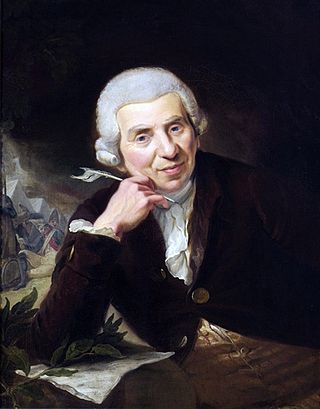
Johann Wilhelm Ludwig Gleim was a German poet, commonly associated with the Enlightenment and Rococo movements.

Fort McHenry is a historical American coastal pentagonal bastion fort on Locust Point, now a neighborhood of Baltimore, Maryland. It is best known for its role in the War of 1812, when it successfully defended Baltimore Harbor from an attack by the British navy from Chesapeake Bay on September 13–14, 1814.

Johann Peter Salomon was a German violinist, composer, conductor and musical impresario. Although an accomplished violinist, he is best known for bringing Joseph Haydn to London and for conducting the symphonies that Haydn wrote during his stay in England. He also knew and worked with Wolfgang Amadeus Mozart and Ludwig van Beethoven.
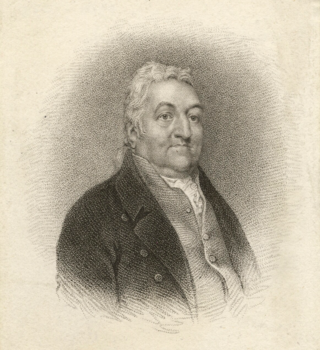
John Stafford Smith was a British composer, church organist, and early musicologist. He was one of the first serious collectors of manuscripts of works by Johann Sebastian Bach and a friend of his son Johann Christian Bach.

"The Anacreontic Song", also known by its incipit "To Anacreon in Heaven", was the official song of the Anacreontic Society, an 18th-century gentlemen's club of amateur musicians in London. Composed by John Stafford Smith, the tune was later used by several writers as a setting for their patriotic lyrics. These included two songs by Francis Scott Key, most famously his poem "Defence of Fort McHenry". The combination of Key's poem and Smith's composition became known as "The Star-Spangled Banner", which was adopted as the national anthem of the United States of America in 1931.
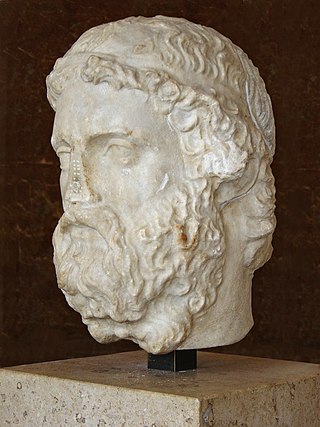
Anacreon was a Greek lyric poet, notable for his drinking songs and erotic poems. Later Greeks included him in the canonical list of Nine Lyric Poets. Anacreon wrote all of his poetry in the ancient Ionic dialect. Like all early lyric poetry, it was composed to be sung or recited to the accompaniment of music, usually the lyre. Anacreon's poetry touched on universal themes of love, infatuation, disappointment, revelry, parties, festivals, and the observations of everyday people and life.

The Battle of Baltimore took place between British and American forces in the War of 1812. American forces repulsed sea and land invasions off the busy port city of Baltimore, Maryland, and killed the commander of the invading British forces.
In music, a catch is a type of round or canon at the unison. That is, it is a musical composition in which two or more voices repeatedly sing the same melody, beginning at different times. Generally catches have a secular theme, though many collections included devotional rounds and canons.
Richard John Samuel Stevens was an English composer and organist.

The Concert Hall (1752–1869) was a performance and meeting space in Boston, Massachusetts, located at Hanover Street and Queen Street. Meetings, dinners, concerts, and other cultural events took place in the hall.
Therese Jansen Bartolozzi was a pianist whose career flourished in London around the end of the 18th century. She was the dedicatee of piano works by a number of famous composers.
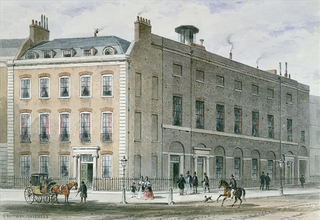
The Hanover Square Rooms or the Queen's Concert Rooms were assembly rooms established, principally for musical performances, on the corner of Hanover Square, London, England, by Sir John Gallini in partnership with Johann Christian Bach and Carl Friedrich Abel in 1774. For exactly one century this was the principal concert venue in London. The premises were demolished in 1900.

The Tonkünstler-Societät was a benevolent society for musicians in Vienna, which lasted from the mid-18th century to the mid-20th. Its purpose was "to support retired musicians and their families". Beginning in 1772, the Society mounted a series of benefit concerts, often with large forces of performers, at which were performed works by leading Classical-period composers, including Joseph Haydn, Wolfgang Amadeus Mozart, and Ludwig van Beethoven.
Benjamin Blake was an English violinist, viola player and composer.

The City of London Tavern or London Tavern was a notable meeting place in London during the 18th and 19th centuries. A place of business where people gathered to drink alcoholic beverages and be served food, the tavern was situated in Bishopsgate in the City of London. The original tavern was destroyed in a fire on 7 November 1765 and the new building was designed by William Jupp the elder and opened in September 1768. In 1828, the proprietor was Charles Bleaden. The building was demolished in 1876. The tavern boasted a large and well-decorated dining room with Corinthian columns. It hosted numerous public and private meetings held to rally support to various political, charitable and other causes.
Ralph Tomlinson, was a British lyricist best known for writing the original lyrics to "The Anacreontic Song". The music from the Anacreontic Song would be set as the music for The Star Spangled Banner, which would become the American national anthem in 1931. In 1776, he became the President of the Anacreontic Society, after the death of the previous President, George Bellas.
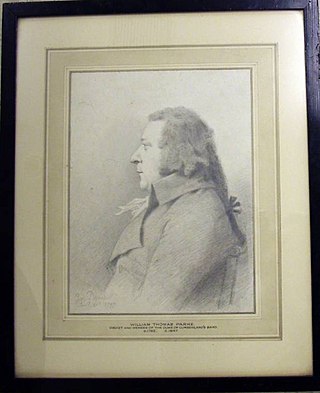
William Thomas Parke was an English oboist and composer. He played in notable concerts of the day; in retirement he published Musical Memoirs.
Charles Knyvett was an English singer and organist. He established in 1791 in London the Vocal Concerts, a series of subscription concerts.
















